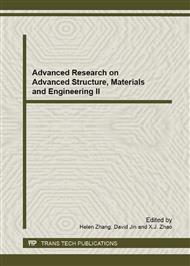p.89
p.93
p.98
p.103
p.107
p.111
p.119
p.123
p.128
Mechanical Properties of Self-Healing Carbon Fibre Fabric Reinforced Polymers (CFFRP)
Abstract:
In this paper, carbon fibre fabric reinforced polymeric composites with the capability of self-healing were studied. These fabric-composite laminates were fabricated by hand lay-up of plain weave (PW) carbon fibre fabrics impregnated with polymer blends of epoxy resin and thermoplastic healing agent. Laminates containing different amounts of healing agent (0, 10wt% and 20wt% by weight of epoxy) were evaluated by tensile and three-point flexural tests according to the ASTM D3039/D3039M and D790, respectively. Aside of the potential for self-healing, benefits were found in terms of tensile and flexural properties. Overall, tensile properties were improved with addition of thermoplastic healing agent; the highest tensile strength and failure strain were obtained with the highest healing agent amount (20wt%) whilst the maximum tensile modulus was obtained at 10wt%. In general, flexural properties were also improved except flexural strain; the highest flexural strength and modulus were determined at 10wt%.
Info:
Periodical:
Pages:
107-110
Citation:
Online since:
May 2013
Authors:
Keywords:
Price:
Сopyright:
© 2013 Trans Tech Publications Ltd. All Rights Reserved
Share:
Citation:


